New Arai Defiant Added to the Lineup
The Arai Defiant (Arai Rebel in the UK) was introduced in 2013 and updated with a few new graphic choices for 2014.
The helmet is similar to the Arai RX-Q (review) but it has a new ventilation system, revised cheek pads and a few other updated features.
I own an RX-Q and I think the Defiant improves on it in several ways, making it a worthwhile upgrade.
For example, the revised ventilation system isn’t just window dressing; it seems more effective than the vents on previous Arai helmets and it even transmits less noise.
The helmet has all of the typical high-end features expected of an Arai, including outstanding fit and finish (and the premium price).
But there’s something about an Arai helmet that just feels different from the proletarian brands in so many ways.
Apparently, many motorcycle riders agree and the Defiant has quickly become a best seller.
You’ll probably see Haley’s comet more often than you’ll see a new Arai helmet introduced. The Defiant appeared last year and it quickly became one of the most popular of the current Arai lineup.
The Defiant didn’t impress me all that much at first. In fact, I was puzzled. Isn’t this simply an RX-Q with some new vent covers?
But once I got my mitts on the example shown here in the “Chopper” graphics (new for 2014) and spent some time with it over the last few weeks, I realized that they’re on to something.
In fact, it pretty much puts the RX-Q — which now seems a bit old-fashioned in comparison — out to pasture.
Those new top vents on the Defiant actually function very well, bringing a lot of air into the helmet without the fairly terrible whistling noise generated by the scoop-type vents like those on the RX-Q and other Arai helmets.
The Defiant’s larger chin vent is also a big (pun) improvement and, when combined with the rear tailpipe exhaust and the new top exhaust spoiler, the helmet flows a lot of air — always a good thing.
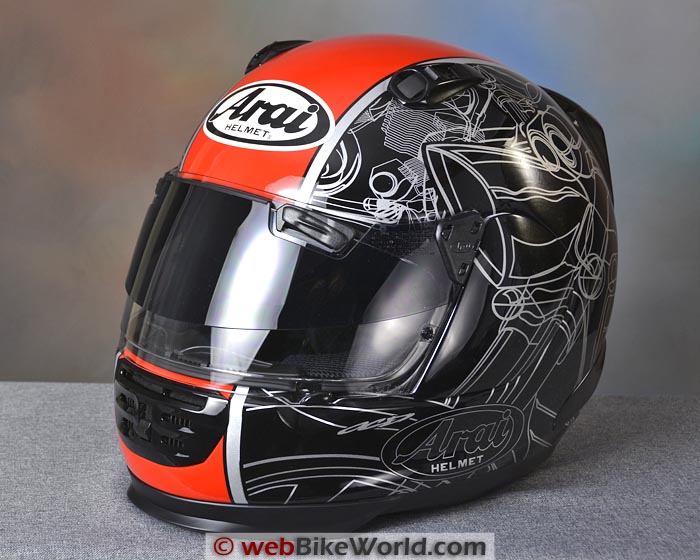
Where to Buy Arai Defiant Helmet
Check Reviews & Prices on Amazon Check Reviews & Prices On RevZillaSee More Motorcycle Helmets, Motorcycle Visor, Motorcycle Intercom
Arai Defiant Paint, Graphics and Overall Quality
An Arai helmet does have a different feel, there’s no doubt about that, and it’s a signal that the extra dosh is actually getting you something of value.
Graphics add zip for protection but the “Chopper” design shown here, which is new for 2014, is beautifully executed, although to be honest, the line drawing on the sides of the helmet may be a bit too finely crafted to make any type of statement.
Arai says the Defiant is “aimed at the urban rider/streetfighter motorcycle segment”.
I had to study the graphics on this helmet for some time before I realized it’s supposed to be — I think — the headlight and forks of what appears to be a Japanese cruiser?
I do like the black, red and silver color combo though and it’s all applied with perfection. The overall build quality and feel of the liner and especially the operation of the new vents is among the best you’ll find.
The liner quality of the Defiant is certainly better than most less expensive helmets and it even feels better than the somewhat scratchy liner fabric in my RX-Q. I’m not sure if Arai has changed fabric types, however.
Bottom line, if you find an Arai that matches your head shape — and chances are you will, because they’re the only motorcycle helmet manufacturer I know of that actually makes helmets with different internal shapes — you’ll notice a difference.
Score: Overall, I’ll rate the Arai Defiant as “Outstanding” for paint and quality. See the Summary Table at the end of this page for a description of our rating system.
Where to Buy Arai Defiant Helmet
Check Reviews & Prices on Amazon Check Reviews & Prices On RevZillaSee More Motorcycle Helmets, Motorcycle Visor, Motorcycle Intercom
Arai Defiant Helmet Fit, Internal Shape and Liner
My feeling is that Arai modified the internal shapes of their helmets a few years ago.
They may not admit it, but we’ve been reviewing Arai helmets for many years and we noticed the change, starting around the time the late and lamented Arai Quantum II (review) was discontinued in the U.S.
That helmet and its “Round Oval” internal shape is gone and “Round” helmets in general are going the way of the Dodo.
Apparently, there are too few “Round” heads in the U.S. to make sales worthwhile. Hard to believe, but what can I say…
Arai says the Defiant has their “Intermediate Oval” shape, just like the RX-Q. It fits my “Earth” shaped head (round and widest at the temples), but not as perfectly as the old Quantum.
The Arai Intermediate Oval shape leaves a little room in the forehead, which I guess is OK for comfort but I’m always wondering if the extra air space I end up with for my head shape won’t protect me as well as it should.
One thing I have noticed is that the Defiant in size XL definitely feels like an XL, while my RX-Q in size XL feels quite snug in comparison. The internal shape or profile of both helmets feels similar, but the RX-Q in XL fits like large, while the Defiant feels correct as an XL.
I’m going to see if I can get a thicker set of cheek pads for the Defiant to pump it up a bit and maybe get it to fit a tad tighter.
Otherwise, the helmet is very comfortable and — although the liner fabric appears to be the same — the Defiant’s liner feels softer than the fabric in my RX-Q.
The Defiant also seems to have a slightly wider opening at the bottom of the helmet shell, which makes it easier to slip on my bulb-shaped head.
Arai uses what they call the “R75” shell shape on the Defiant and I don’t remember them using that terminology when I bought the RX-Q, so maybe that’s what makes a difference.
The R75 shell shape refers to the 75 mm radius used for the shell.
This is claimed to be a rounder and smoother shape that’s also stronger, which can help to divert or deflect impact energy by sliding and not catching on uneven surfaces and glancing off obstacles.
Also, the external vents and hardware on Arai helmets are designed to break off in the event of a crash, further minimizing the risk of catching or digging in during a spill.
In webBikeWorld helmet internal shape classification terms, I’ll have to end up characterizing the Defiant-Q as a “Neutral” shape shaded towards “Slightly Narrow”.
But I think the Arai “Intermediate Oval” shape will fit most head shapes, because it has the extra forehead room for “Slightly Narrow” heads but it also fits “Round” heads like mine quite comfortably.
The size XL fits a 61-62 cm head and as I mentioned, I think it fits to size.

The liner padding in the Defiant is also very comfortable — as most Arai helmets are. But the chin strap padding is still way too short. I’m not sure why Arai insists on such short straps, but it’s the one thing that is uncomfortable on their helmets. I’ve complained about this in almost every Arai helmet review and it’s no different with the Defiant.
More information on helmet fit can be found in the webBikeWorld Motorcycle Helmet FAQ page, along with the chart that lists the helmet weights of webBikeWorld reviewed helmets and also by shape on the webBikeWorld Motorcycle Helmet Shapes page.
Score: I’ll give the Defiant an “Outstanding” for an internal shape that should fit a wide majority of head shapes.
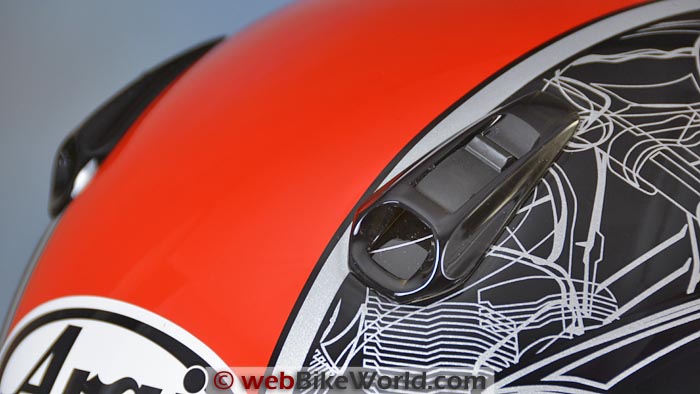
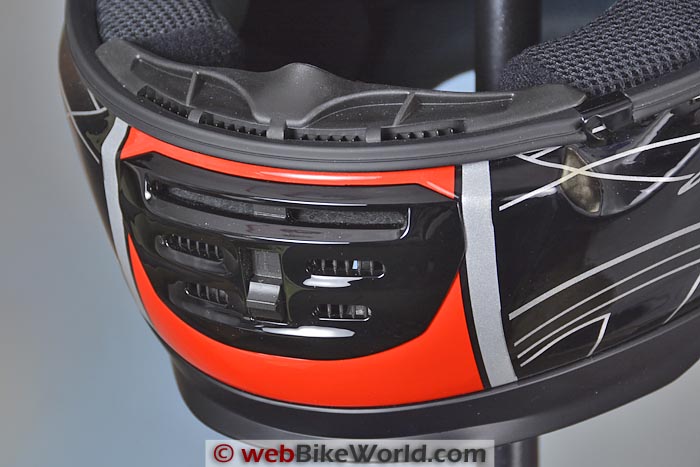
Face Shield, Eye Port and Visibility
The face shield on the Defiant is standard Arai. It’s the “SAI Max-Vision” type they released a few years ago, said to be 5 mm wider than the original.
It includes the two brow vents at the top that can be opened half-way and all the way (does anyone ever use the half opening?).
It directs air through vent channels attached to the top of the eye port and then through the liner and on to the rider’s head at about eyebrow level.
The visibility from the Defiant is about the same as the RX-Q. It’s good, but not great.
That’s probably because Arai keeps the eye port a bit smaller to add some protection. So overall, I’d rate it as perhaps slightly better than average for visibility.
The face shield also uses the standard Arai friction system to hold it open when raised.
This allows a virtually unlimited choice for positioning, which I like and the face shield does not twist or torque when raised or lowered.
The standard Arai face shield removal system is included and I’ve learned to use it without a problem.
It does take a bit of practice at first because it is different and perhaps more complex than something like an HJC system, but once you get the hang of it, there shouldn’t be a problem. I included a quick tutorial on this in the video below.
Arai says that a deliberate effort was made to eliminate as many protuberances on the helmet and face shield, thus the shield does not have a lift tab, only a locking snap at the lower left.
It works well but it may take some time for new Arai owners to become accustomed to using it, as it holds the face shield tightly to the eye port.
One thing for sure about the “snap ‘n’ hold” system: it keeps the face shield tight against the eye port gasket.
The gasket completely surrounds the eye port (not all helmets have this feature), and the combination of the tight fit and full gasket make the face shield watertight.
Arai includes a Pinlock “Max” system with the helmet. I’m not a big fan of Pinlock inserts and almost never install them, but then again, I don’t seem to have much of a problem with fogging.
The Defiant ventilation system works well enough and the face shield can be cracked open for defogging anyway.
The Defiant face shield is labeled as meeting VESC-8 standards. I measured it at 2.21 mm thick, slightly thicker than the non-Pinlock RX-Q face shield at 2.10 mm thick.

Score: I’ll give the Defiant an “Excellent” for above average outward visibility and the sealing performance of the face shield.
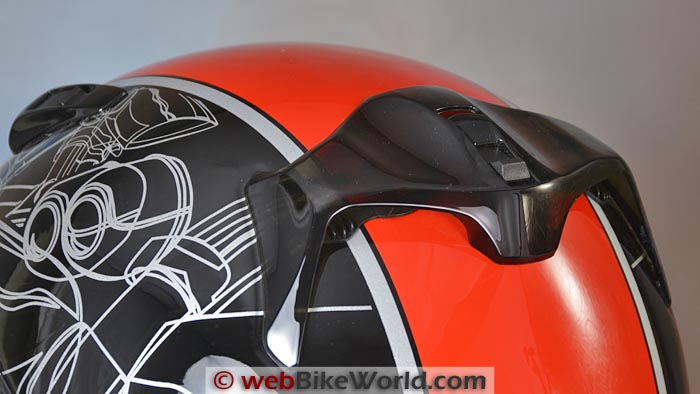
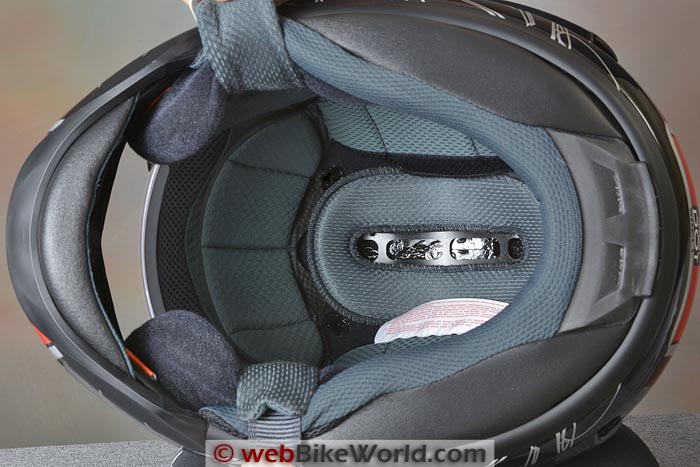
Where to Buy Arai Defiant Helmet
Check Reviews & Prices on Amazon Check Reviews & Prices On RevZillaSee More Motorcycle Helmets, Motorcycle Visor, Motorcycle Intercom
Ventilation
The ventilation system on the Defiant is all new and, quite frankly, it’s about time, as the older Arai system has been used on too many of their helmets.
It was adequate, but just seemed (seems) old-fashioned and the top vents on my RX-Q generate a lot of whistling noise.
There never seemed to be much enthusiasm in the old Arai top vent design, more like “Let’s throw some plain ol’ scoops on this thing and be done with it.”
When I first saw the Defiant, I thought the new vents were a gimmick, added to give the helmet an updated appearance.
But it wasn’t long into the first ride when I realized that the system actually works better than any previous Arai helmet I’ve worn and it’s also quieter. Now that’s progress!
The chin vent is much larger and it flows air along the top of the chin bar and directly through the chin bar through a set of four vertical slots when the slider is at the lowest position.
Click the slider up half-way and the air flows up along the top of the chin bar only. The topmost position closes the vent completely.
The vent has a solid feel although I wish the lift tab for the slider was just a touch bigger.
The top vents are immediately noticeable as different from any other Arai helmet. They’re low-profile rectangular-shaped ducts and the slider also has a very nice and solid click feel.
The vents close all the way, then half open and then fully open. The air is directed down into the helmet, where there are large channels and openings in the top of the liner to make sure the air flows across the rider’s head.
The rear vent diffuser also has a three-position switch and it seems to help pull the air through the helmet. Overall, it’s an excellent system and an improvement over previous Arai helmets.

Score: I’ll give the Defiant ventilation system and operation of the parts a score of “Outstanding”
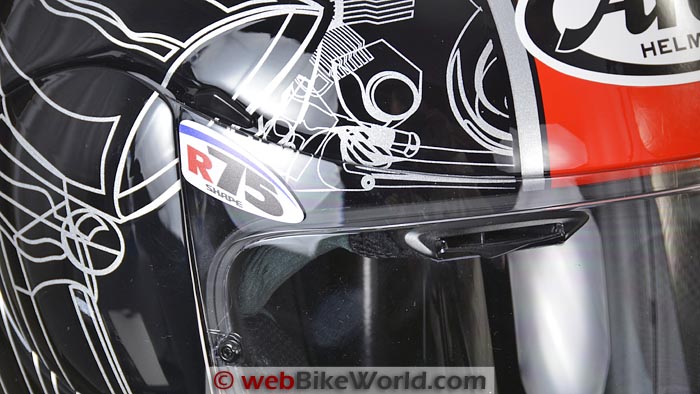
Arai Defiant Sound Levels
The Defiant is quieter than my RX-Q, if that means anything. The sound levels are controlled pretty nicely, although you have to make sure the internal shape matches your head shape and that you buy the correct size.
The top vents are noticeably quieter than the whistling RX-Q scoop-type vents.
The Defiant is targeted at standard bikes and “streetfighters”, according to Arai; i.e., motorcycles without a fairing.
A slightly leaned-forward position seems to combine the lowest noise levels with optimum ventilation.
Arai said that the cheek pads on the Defiant are new.
To be honest, I don’t notice much of a difference compared to my RX-Q, although as I mentioned earlier, the sizing differences may account for that.
The Defiant feels looser than the same size (XL) RX-Q, so I’ll have to buy a pair of thicker cheek pads and see if that makes a difference.
Overall though, I’d rate the Defiant as slightly quieter than average at the top and along the bottom.

Score: I’ll give the Defiant an “Excellent” for slightly better than average noise levels and ability to control noise.
Helmet Weight
This Arai Defiant in size XL weighs 1707 grams (3 lbs. 12-1/4 oz.), about 200 grams heavier than an RX-Q in size L (the first RX-Q I owned), which weighed 1597 grams.
1707 grams is about average, neither heavy nor light. For comparison, the HJC CL-16 (review) in size XL weighs 1702 grams; the Shoei GT Air (review) in size large weighs 1727 grams; the Kabuto FF-5V (review) in size XL weighs 1734 grams; the Arai Corsair V (review) in size XL weighs 1758 grams.
The old Arai Quantum II (review) in size XL weighed 1624 grams; and the Shoei X-Eleven (XL) was 1635 grams.
All of these weights are available on the wBW Motorcycle Helmet Weights page, along with a chart that lists the helmets by weight and shape on the wBW Motorcycle Helmet Shapes page.
Score: I’ll give the Defiant a “Very Good” for relatively low weight and excellent balance.
Miscellaneous
The Defiant has a five-year warranty. The chin strap uses double D-rings.
Different sized cheek pads and liner parts are available for a custom fit.
The chin strap padding is too short, as it is on every Arai helmet we’ve reviewed. C’mon Arai, how about an extra 25 mm or so of padding? It would make a real difference.
The Defiant meets the DOT standard and it is Snell M2010 certified in the U.S. The helmet is sold as the Arai Rebel in the UK and it’s currently on sale with a special deal: a free Arai Pro Shade (review) when you buy an Arai Rebel.
That’s quite a deal! The Rebel received 3 stars in the SHARP helmet testing program, losing points for side impact.
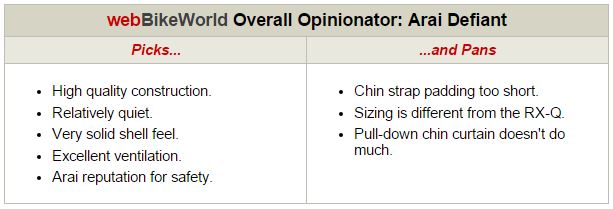
Conclusion
The Arai Defiant is a nice update to the RX-Q, although I don’t think Arai sees it that way. The Defiant has its own place in the current Arai lineup, curiously placed between the Arai Signet-Q (review) and the Arai Vector 2 (review).
The ventilation system on the Defiant is an improvement over previous Arai systems, so we’ll see if it spreads to the older helmets as they’re updated.
The XL Defiant has a different size than the XL RX-Q, based on our comparisons of both helmets that I currently have available. I’m not sure if that’s by design or if it’s an aberration.
The Defiant has the typical Arai solid construction, excellent sealing between the face shield and the eye port gasket and the Arai reputation for safety. Overall, I like the Defiant and its become my “go to” helmet for daily use.
| wBW Product Review: Arai Defiant Helmet | |
|---|---|
| Manufacturer: Arai Helmet Ltd. | List Price: $619.95 to $749.95 |
| Colors: Solids and graphics. | Made In: Japan |
| Sizes: 2XS-3XL | Review Date: June 2014 |
| Shell Sizes: 3 (estimated) | |
|
Rating Scale is subjective: Unacceptable, Poor, Neutral, Very Good, Excellent, Outstanding.
|
|
Where to Buy Arai Defiant Helmet
Check Reviews & Prices on Amazon Check Reviews & Prices On RevZillaSee More Motorcycle Helmets, Motorcycle Visor, Motorcycle Intercom
Owner Comments and Feedback
See details on submitting comments.
From “J.B.” (July 2014): “I bought the Defiant and like it, but there are a few interesting thing about the ventilation that I thought I would share.
Of course, everyone has a different experience depending on bike, head shape, etc.
To start with, Arai advertises this helmet as designed for upright and 3/4 naked bikes. That should be perfect for me as I ride a KLR (upright) and a ZRX (3/4).
By far, the most impressive part of the ventilation to me are the brow vents. When they are flowing, the pour large amounts of cool air over my temples, even reaching the ears through the eye glasses gap.
They do a great job of adding cooling and comfort with one exception.
In order to get the brow vents to flow, I have to tilt my head forward, chin down as it were. When in my normal riding position, I can’t feel any air flow through the brow vents.
Even on the ZRX I find myself riding in my normal position and, occasionally, dipping my head down to get a brief flow of air over my temples. This is something that Arai should work on improving.
The chin vents look huge. A big grille opening on the outside and 4 big channels running straight through the chin bar. Looking at the chin vents, I expected massive flow, but instead the flow is only as good as my older helmets.
Good, but not great. In the meantime, my eyes are getting dried out by lots of air flowing up the shield, around my glasses, and into my eyes.
I wish that Arai had taken the chin control a little bit farther and made a position where the mouth vents were open, but the shield vent was closed.
I give Arai two thumbs up for fit and comfort. I returned two other helmets because they didn’t fit before stepping up to the Arai. I also give them props for offering a XXXL size.
The XXL worked for me, but those of us with fat heads appreciate the option of the big size.”
Editor’s Note: Note that even small windscreens can dramatically affect the way the air flows over, through and around a helmet.
From “E.W.” (June 2014): “Only 3 stars in the SHARP helmet rating. Spending this much on a helmet, I’d hope for a safer helmet.
I notice you sometimes reference a helmet getting 5 stars in other helmet review. But don’t seem to see you mention a helmet getting a low score. Love the reviews though. Keep up the good work.”
Editor’s Reply: Actually, we did mention the 3 star SHARP rating in the Defiant review (in the “Miscellaneous” section), you must have missed it. It’s not confirmed that the Rebel uses exactly the same components as the Defiant.
Personally, I’m not convinced SHARP is as accurate or meaningful as other standards.
That’s because the U.S. version of the Defiant meets both DOT and the tough Snell M2010 certification, which, according to European helmet manufacturers I’ve talked to, is not possible to meet with an ECE-only shell.
Arai helmets seem to rate poorly in the SHARP tests, for some reason, yet Arai is one of the most popular brands with motorcycle racers where it really counts, on the race track.
I rarely check the SHARP ratings, focusing instead on U.S. standards. Very occasionally, however, whomever is reviewing the helmet (check the author’s name in each, we have several reviewers) adds a SHARP rating.
By the way, you want to see real world helmet crash testing rather than some CE or Snell lab theory? Watch any MotoGP or World Superbike race and see what the riders are wearing. Then buy it.
From “M.G.” (June 2014): “I’ve had the Defiant since it was first released, and it is far and away the best venting, most comfortable, highest quality helmet that I have ever owned.
The most impressive feature by far is the venting. My first ride with it on was an absolute shock. I figured with vents that appear to have been pulled off a MIG 25 that it would move some serious air, but at 10 mph???!!!
My only wish would be a little more field of view from the visor, but even that isn’t bad. Arai has a new customer for life if they continue with this level of quality.”
From “W.C.” (June 2014): “I have a long oval head and can wear the RX-Q and I own a Signet-Q. The Defiant definitely does not fit my head the same way the RX or Signet fit. It hurts to even put it on in comparison. Just wanted to share.
The Defiant felt significantly rounder to me. Loose on the sides but lots of front and rear pressure. I have a 57.5 cm head circumference that is a little more than an inch longer than wide. This is a size medium for Arai and that’s what I tried on.
The Defiant might fit if I went larger but like you say in the review. Probably not as safe.”

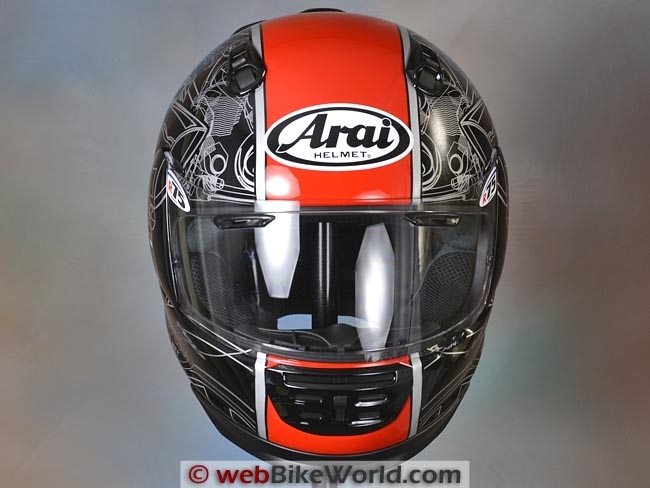
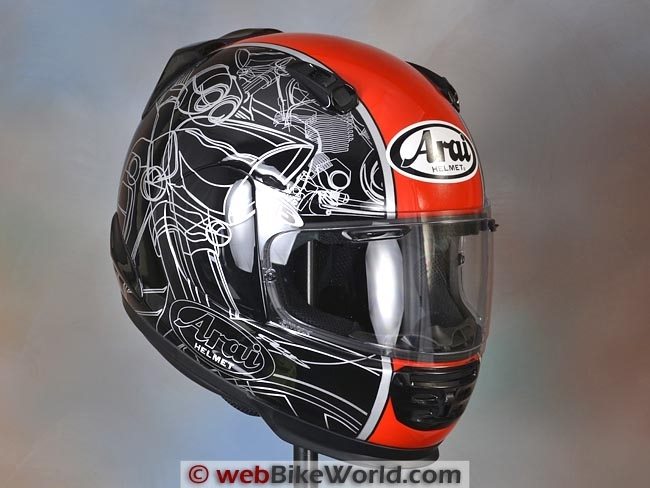
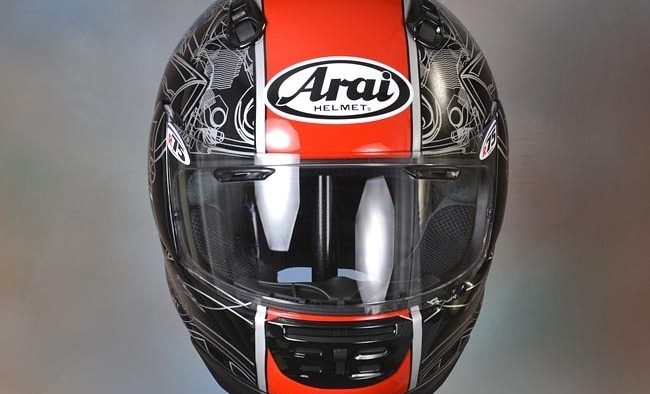
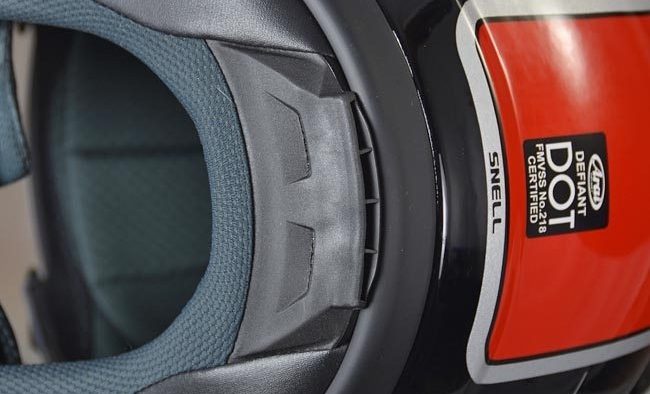
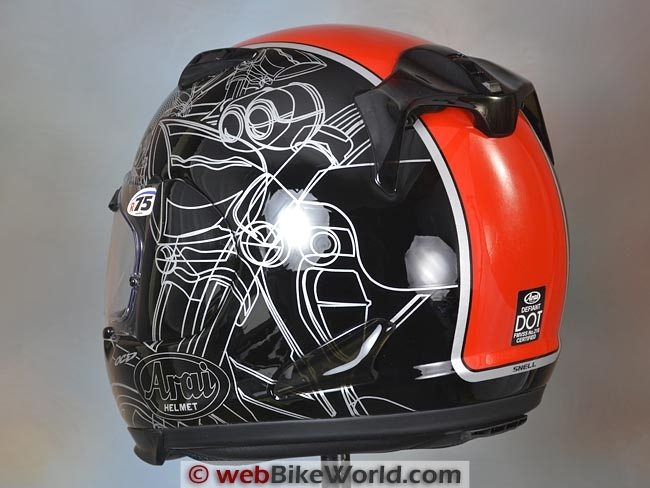
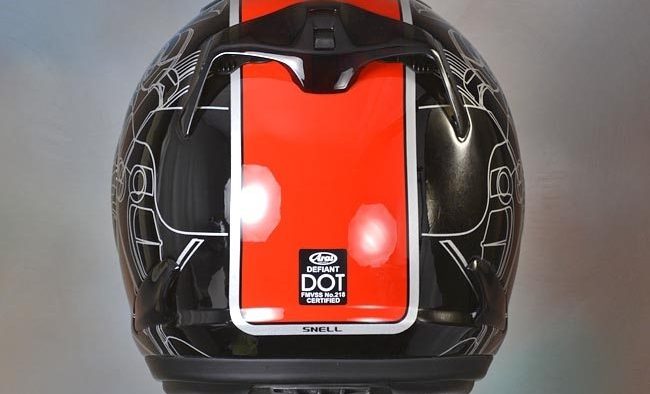
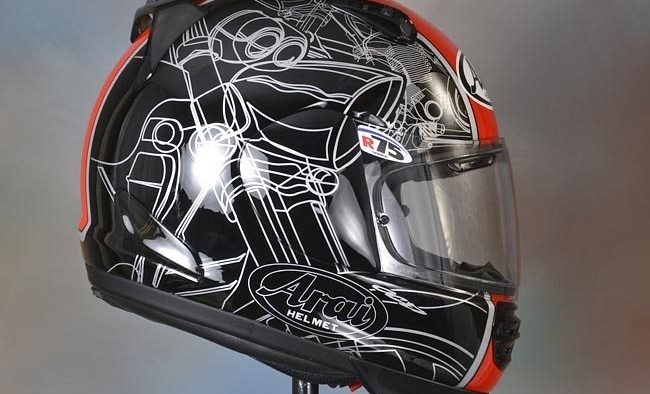
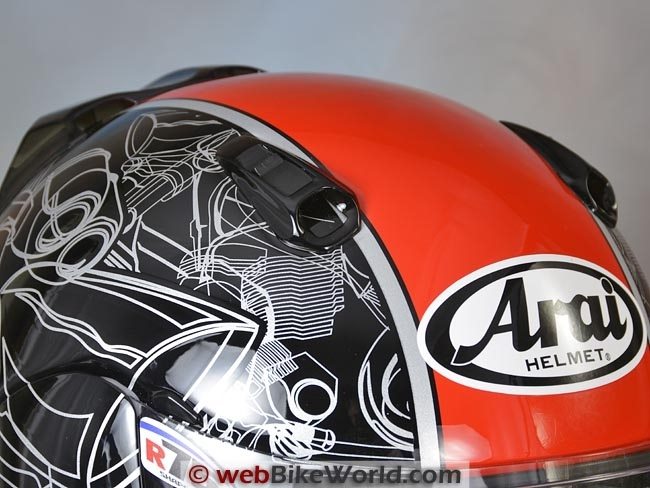
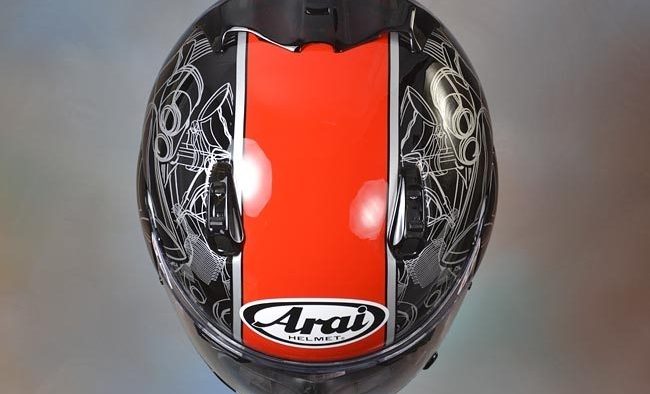
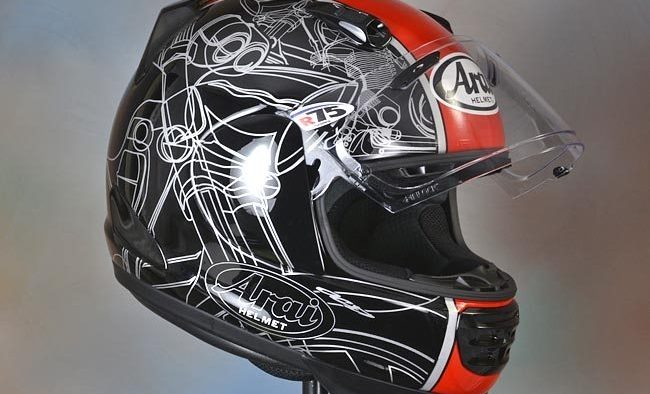


No Comment